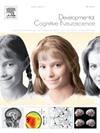The optic radiations and reading development: A longitudinal study of children born term and preterm
IF 4.9
2区 医学
Q1 NEUROSCIENCES
引用次数: 0
Abstract
Purpose
To determine if reading development between ages 6 and 8 years related to changes in fractional anisotropy (FA) in the optic radiations (OR), and if these associations were similar in children born full term (FT) and preterm (PT) and in language tracts.
Methods
FT (n = 34) and PT (n = 34) children completed the Word Identification subtest of the Woodcock Reading Mastery Test at 6, 7, and 8 years. Diffusion MRI (96-directions, b=2500 sec/mm2) was acquired at 6 and 8 years. Probabilistic tractography identified bilateral OR and three left-hemisphere language tracts: inferior longitudinal fasciculus (ILF), superior longitudinal fasciculus (SLF), and arcuate fasciculus (AF). Linear mixed models determined if FA changes in these tracts were associated with reading growth.
Results
Rates of reading growth were similar in both groups. For the OR, FA change from 6 to 8 years was negatively associated with reading growth in both groups. A similar pattern was observed in the left ILF but not in the SLF or AF.
Conclusion
Individual differences in reading development were associated with FA change of the OR and left ILF in FT and PT children. Negative associations implicate increasing axonal diameter and/or complexity in fiber structure as drivers of faster reading development.
视光辐射与阅读发展:足月和早产儿的纵向研究。
目的:确定6至8岁之间的阅读发育是否与视光辐射(OR)的分数各向异性(FA)的变化有关,以及这些关联是否在足月出生的儿童(FT)和早产儿(PT)以及语言区域中相似。方法:FT儿童(n = 34)和PT儿童(n = 34)分别在6、7、8岁完成Woodcock阅读掌握测验的单词识别子测试。6岁和8岁时进行弥散MRI(96个方向,b=2500 sec/mm2)。概率神经束造影确定了双侧OR和三个左半球语言束:下纵束(ILF)、上纵束(SLF)和弓形束(AF)。线性混合模型确定了这些神经束的FA变化是否与阅读增长有关。结果:两组的阅读增长速度相似。对于OR, 6至8年的FA变化与两组的阅读增长呈负相关。结论:阅读发育的个体差异与FT和PT儿童or和左侧ILF的FA变化有关。负相关暗示增加轴突直径和/或纤维结构的复杂性作为更快阅读发展的驱动因素。
本文章由计算机程序翻译,如有差异,请以英文原文为准。
求助全文
约1分钟内获得全文
求助全文
来源期刊

Developmental Cognitive Neuroscience
NEUROSCIENCES-
CiteScore
7.60
自引率
10.60%
发文量
124
审稿时长
6-12 weeks
期刊介绍:
The journal publishes theoretical and research papers on cognitive brain development, from infancy through childhood and adolescence and into adulthood. It covers neurocognitive development and neurocognitive processing in both typical and atypical development, including social and affective aspects. Appropriate methodologies for the journal include, but are not limited to, functional neuroimaging (fMRI and MEG), electrophysiology (EEG and ERP), NIRS and transcranial magnetic stimulation, as well as other basic neuroscience approaches using cellular and animal models that directly address cognitive brain development, patient studies, case studies, post-mortem studies and pharmacological studies.
 求助内容:
求助内容: 应助结果提醒方式:
应助结果提醒方式:


